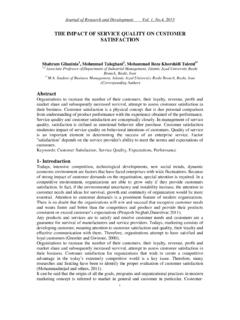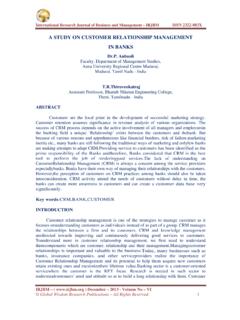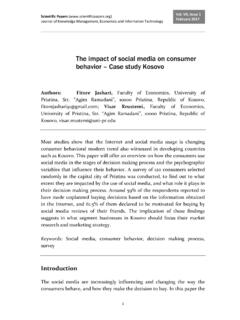Transcription of CHAPTER 5: HANDLING DIFFICULT CUSTOMER SITUATIONS
1 CHAPTER 5: HANDLING DIFFICULT CUSTOMER SITUATIONS A Guide to CUSTOMER Service Skills for the Service Desk Professional Third Edition 2 OBJECTIVES The power of a positive attitude Why customers sometimes behave in challenging ways Proven techniques to handle irate, DIFFICULT , and demanding customers How to respond, not react, to DIFFICULT CUSTOMER SITUATIONS Positive steps to stay calm and in control 208 Ch. 5: HANDLING DIFFICULT Customers 3 HANDLING DIFFICULT CUSTOMER SITUATIONS Most customers are pleasant, calm, and appreciative of analysts efforts There are times when customers become upset, angry, and demanding These DIFFICULT SITUATIONS can be extremely stressful You cannot control your customers behavior You can control your response to their behavior You can develop the skills needed to handle even the most DIFFICULT SITUATIONS 209 Ch. 5: HANDLING DIFFICULT Customers TOPIC 1: THE POWER OF A POSITIVE ATTITUDE 209 "THINGS TURN OUT BEST TO PEOPLE THAT MAKE THE BEST OF THE WAY THINGS TURN OUT.
2 " - John Wooden Ch. 5: HANDLING DIFFICULT Customers 5 6 HANDLING UPSET, ANGRY, & DEMANDING CUSTOMERS We all have bad days Most customers who contact the service desk are reasonable, pleasant, and grateful for your help DIFFICULT CUSTOMER SITUATIONS are the exception, not the rule DIFFICULT SITUATIONS can affect your attitude and your interactions with customers Try to consider and treat each CUSTOMER and each situation as unique 209 Ch. 5: HANDLING DIFFICULT Customers 7 UNDERSTANDING CUSTOMER BEHAVIOR PART 1 OF 3 Empathy The act of identifying with and understanding another person s situation, feelings, and motives Being empathetic does not mean you are responsible It is your responsibility to acknowledge that the CUSTOMER is upset and do everything you can to help The frustration a CUSTOMER experiences dealing with a technical problem may be compounded when he or she tries to obtain support Your company or department may be responsible for SITUATIONS that cause frustration or confusion Ch.
3 5: HANDLING DIFFICULT Customers 210 8 Broken promises Long wait times Confusing telephone menus Confusing user instructions or online help Unmet expectations Having to call or e-mail back repeatedly Having to repeat details previously provided Looming deadlines Negative phrases Poor product quality Rude analysts Being placed on hold without being asked Being placed on hold for an extended period of time Web sites that are DIFFICULT to navigate, inaccurate, or incomplete Web sites that fail to offer alternate ways to obtain support Ch. 5: HANDLING DIFFICULT Customers UNDERSTANDING CUSTOMER BEHAVIOR PART 2 OF 3 211 9 Remember that there is always something that you can do Communicate each and every CUSTOMER complaint to management Give your customers the benefit of the doubt; they may just be having a bad day Be honest and don t blame customers for your lack of patience or negative attitude Maybe you are the one having a bad day!
4 Strive to be positive and professional at all times Ch. 5: HANDLING DIFFICULT Customers UNDERSTANDING CUSTOMER BEHAVIOR PART 3 OF 3 212 10 WINNING OVER DIFFICULT CUSTOMERS PART 1 OF 9 Working with DIFFICULT customers requires patience and composure How you respond to DIFFICULT customers, particularly during the early moments of your conversation, will greatly influence their perception and willingness to work with you You can make a DIFFICULT situation worse by failing to: Listen Empathize with the CUSTOMER s situation Communicate with positive statements Ch. 5: HANDLING DIFFICULT Customers 216 11 Step 1. Get Focused: Take a deep breath. Put a smile on your face. Sit or stand up straight. Get your notepad ready. Step 2. Let the CUSTOMER Vent: An upset or angry CUSTOMER has a story to tell You must let the CUSTOMER tell that story from beginning to end Until each point is made, the CUSTOMER cannot calm down Listen actively and look for cues that the CUSTOMER is ready for you to begin taking control Ch.
5 5: HANDLING DIFFICULT Customers WINNING OVER DIFFICULT CUSTOMERS PART 4 OF 9 217 12 Step 3. Listen Actively: Resist the temptation to ask questions Nod your head or use encouraging verbal phrases Uh-huh. Go on. I see. I understand. Listen carefully for the central theme of the person s incident or complaint Take notes and be prepared to restate what you have heard Ch. 5: HANDLING DIFFICULT Customers WINNING OVER DIFFICULT CUSTOMERS PART 5 OF 9 217 13 Step 4. Acknowledge the CUSTOMER s Emotional State: A CUSTOMER needs to feel that you care and that you fully understand the situation Acknowledge the CUSTOMER s emotion Even if you don t understand why the CUSTOMER has that emotion Empathize or at least accept that this CUSTOMER may be having a really bad day and needs your help Respectfully use the CUSTOMER s name and communicate your desire to do all you can Sincerely apologize if your company has caused any inconvenience Ch.
6 5: HANDLING DIFFICULT Customers WINNING OVER DIFFICULT CUSTOMERS PART 6 OF 9 218 14 Step 4. Acknowledge the CUSTOMER s Emotional State (continued): Miss Navarro, I m sorry our field service engineer did not arrive at the time promised. Let me find out what happened. Would you like to hold while I contact his office, or would you like me to call you back? Mr. Sheng, I understand that you are very upset. I will do everything I can to get this printer problem resolved right away. Ch. 5: HANDLING DIFFICULT Customers WINNING OVER DIFFICULT CUSTOMERS PART 7 OF 9 218 15 Step 5. Restate the Situation and Gain Agreement: You must gain agreement that you fully understand the situation and the CUSTOMER s expectation about when a solution will be delivered Restate the problem Use the CUSTOMER s exact words when possible Use a verifying statement Is that correct? Ask for clarification when you do not understand I m sorry, I m confused.
7 Could you Ch. 5: HANDLING DIFFICULT Customers WINNING OVER DIFFICULT CUSTOMERS PART 8 OF 9 219 16 Step 6. Begin Active Problem Solving: If steps 1 through 5 were followed, the CUSTOMER should have calmed down Begin diagnosing the incident and developing an action plan Stay focused! If necessary, repeat some or all of these steps for HANDLING a DIFFICULT situation Ch. 5: HANDLING DIFFICULT Customers WINNING OVER DIFFICULT CUSTOMERS PART 9 OF 9 220 17 CALMING IRATE CUSTOMERS PART 1 OF 5 Customers do not start out irate They re typically just frustrated or confused In most cases, anger can be avoided Use the technique for HANDLING DIFFICULT SITUATIONS Properly handle SITUATIONS such as placing CUSTOMER on hold and transferring customers People experience varying degrees of anger Initially, a CUSTOMER describes the inconvenience of the incident or situation I ve had to wait 20 minutes to get through. Why can t you people learn to pick up the telephone?
8 Ch. 5: HANDLING DIFFICULT Customers 221 18 To calm the CUSTOMER and gain his or her confidence: Acknowledge the CUSTOMER s frustration State that you will do all you can I m sorry to keep you waiting. How can I help you?" If you fail to acknowledge the CUSTOMER s emotion, the CUSTOMER may become angry He or she perceives you do not understand or that you are not listening You re not listening. Let me say it again. Ch. 5: HANDLING DIFFICULT Customers CALMING IRATE CUSTOMERS PART 2 OF 5 222 19 If you are listening, you have not communicated that you are listening You may have acknowledged what the CUSTOMER said, but not how the CUSTOMER said it The CUSTOMER is either going to give you one more chance or he is going to ask to speak with someone else Make sure you understand how to engage help if you need it Ch. 5: HANDLING DIFFICULT Customers CALMING IRATE CUSTOMERS PART 3 OF 5 222 20 Ch. 5: HANDLING DIFFICULT Customers CALMING IRATE CUSTOMERS PART 4 OF 5 223 Technique for HANDLING offensive or abusive language 21 Some customers will become irate even if you have done your best They may have unrealistic expectations They may be trying to manipulate you They may be under so much stress that they are incapable of calming down Ensure that your actions do not drive customers to their irate state Understand that customers may be responding to your behavior, or what they perceive is your behavior, when they become increasingly angry Keep it positive and focus on what you can do Ch.
9 5: HANDLING DIFFICULT Customers CALMING IRATE CUSTOMERS PART 5 OF 5 223 22 REPAIRING A DAMAGED CUSTOMER RELATIONSHIP PART 1 OF 3 Dissatisfied customers will continue doing business with a company if their incidents and complaints are consistently handled quickly and cheerfully Never assume that just because a CUSTOMER seems happy when you complete a contact that you have regained that CUSTOMER s trust Patience and consistent follow-through are required to repair a damaged relationship Ch. 5: HANDLING DIFFICULT Customers 225 23 Follow-through The act of keeping your promises, including getting back to the CUSTOMER when you said you would even if you don t have a resolution to the incident Follow-up The act of having a service desk or company representative verify that the CUSTOMER s incident has been resolved to the CUSTOMER s satisfaction and that the incident has not recurred Ch. 5: HANDLING DIFFICULT Customers REPAIRING A DAMAGED CUSTOMER RELATIONSHIP PART 2 OF 3 225 24 While uncomfortable, following up is the only way to repair a damaged relationship It enables you and the CUSTOMER to feel comfortable when working together in the future When SITUATIONS are handled properly, even the most disgruntled CUSTOMER can become the service desk s greatest advocate Ch.
10 5: HANDLING DIFFICULT Customers REPAIRING A DAMAGED CUSTOMER RELATIONSHIP PART 3 OF 3 226 TOPIC 2: KEEPING YOURSELF IN CONTROL 226 26 KEEPING YOURSELF IN CONTROL Be prepared for DIFFICULT SITUATIONS ! Learn to respond, not react Stay calm under pressure Get ready for your next contact Ch. 5: HANDLING DIFFICULT Customers 226 27 LEARNING TO RESPOND, NOT REACT Reacting is easy Without thinking you say or do the first thing that comes to mind Responding involves making a conscious choice to control your behavior As a professional, it is your responsibility to act in a positive, constructive way, regardless of the CUSTOMER s behavior Try to think rationally about what the CUSTOMER needs and respond calmly to that need Ch. 5: HANDLING DIFFICULT Customers 227 28 STAYING CALM UNDER PRESSURE PART 1 OF X People experience stress and pressure differently Learning to stay calm under pressure requires that you learn to control your behavior As a human being, you can lose your mind on any given day This is because different sides of our brain handle logic and emotion Ch.







